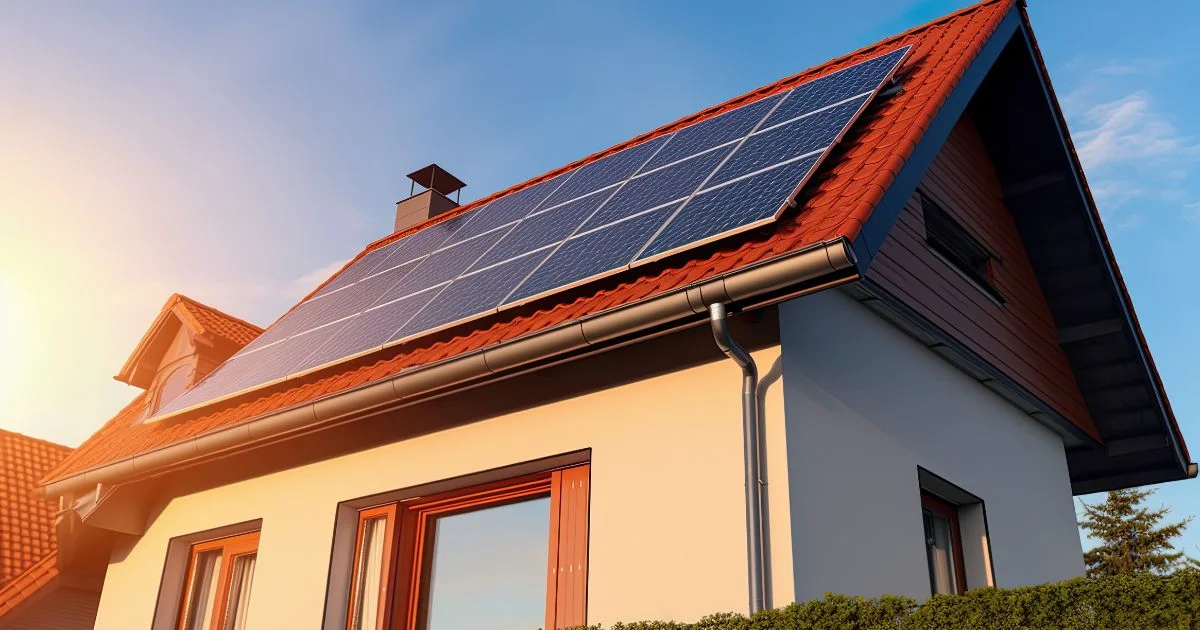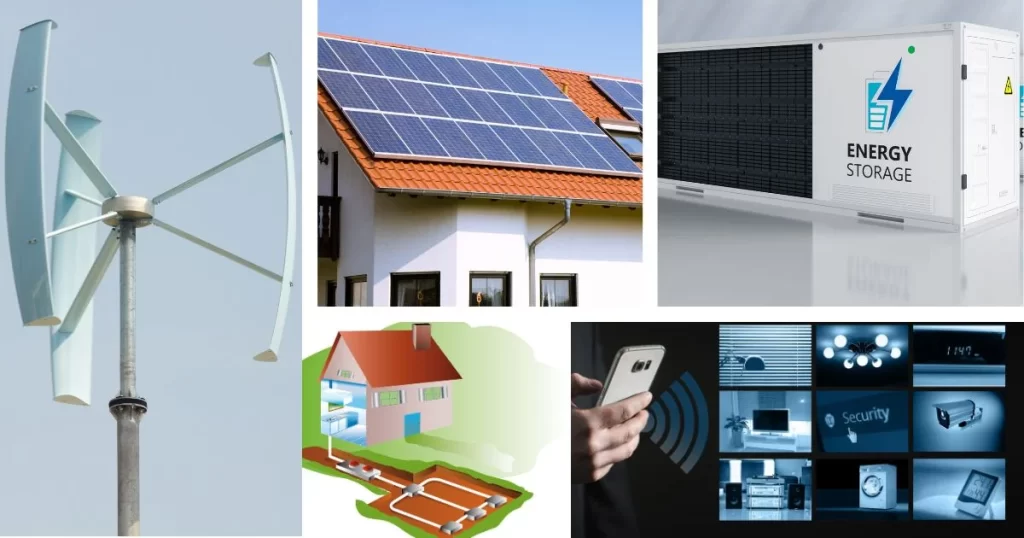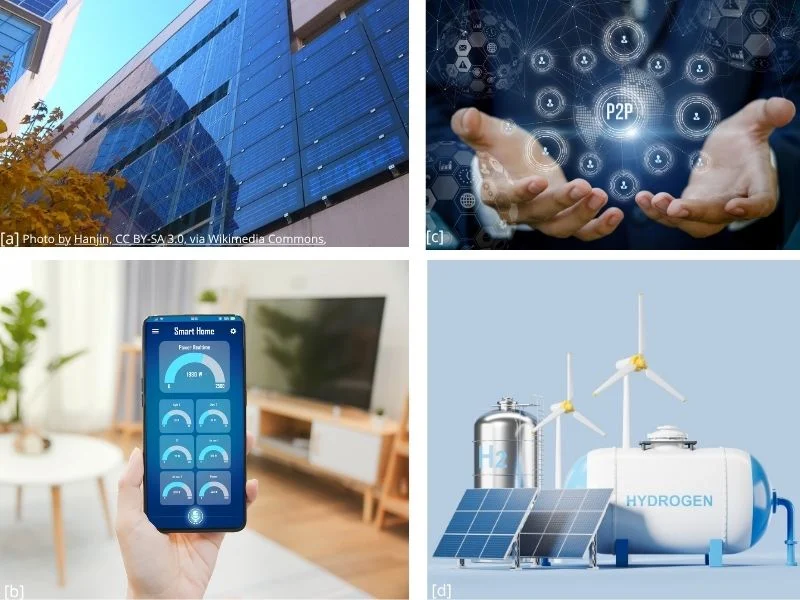Green Energy Solutions: How to Power Your Home Efficiently today
By Mz Chaker & EAGC │June 25, 2025
Explore cutting-edge green energy solutions to power your home efficiently, cut costs, and embrace a cleaner, sustainable future.

Introduction: Embracing the Power of Change
In a world facing rising energy prices and urgent climate warnings, one question echoes louder than ever: How can we power our homes more efficiently without harming the planet? The answer lies in bold, smart, and sustainable choices. Across the globe, families are turning to Green Energy Solutions to take back control—cutting energy bills, reducing carbon footprints, and living more consciously. But while the technology is here, many households still hesitate, unsure where to begin or how to make it work.
That’s the real disruption: the gap between potential and action. Now is the time to bridge that gap—with clarity, purpose, and practical strategies that bring clean energy home. This article explores what Green Energy Solutions truly mean for everyday homeowners. What systems are the most effective today? How can you know which option meets your needs best? And most importantly, how do you make the switch without regret?
The following guide will summarize the core technologies that make sustainable living possible. You’ll learn how to assess your home, choose the right system, and follow the lead of real-world pioneers already reaping the benefits. Let’s build a home that works smarter, not harder—for your wallet, comfort, and the planet.
1. What are Green Energy Solutions? Power with Purpose
To understand the full potential of Green Energy Solutions, we first need to look at the fundamentals—what they are, how they work, and why they matter. In this section, we’ll break down the core principles that define Green Energy, explore the key technologies reshaping residential living, and explain how these systems contribute to a more resilient and sustainable lifestyle.
Definition and Core Principles
Green Energy Solutions refer to clean, Renewable Energy systems that reduce or eliminate reliance on fossil fuels. These technologies draw power from natural resources like sunlight, wind, and the earth’s heat—all of which regenerate naturally. The goal is to provide Efficient, Low-Carbon Energy that minimizes environmental impact while offering long-term savings and resilience for homeowners.
At their core, Green Energy Solutions emphasize four key principles:
- Sustainability: Using energy sources that are clean, infinite, and cause minimal ecological harm.
- Efficiency: Reducing waste by making energy systems smarter and more targeted.
- Resilience: Building reliable energy systems during power outages or grid failures.
- Accessibility: Designing scalable, affordable, and adaptable solutions to different home types.
These principles align with the values of Sustainable Architecture, where green design choices focus on long-term environmental, economic, and human well-being. Homeowners can power their lives purposefully by integrating Green Design, technology, and behavioral shifts while helping build a better Green City future.
Technologies that Power a Sustainable Home
Modern homes now have a wide range of renewable energy systems. Depending on a home’s layout and climate, these systems can work independently or in harmony. Here are some leading Green Energy Solutions technologies:
- Solar Panels: These capture sunlight and convert it into usable electricity. They’re one of the most popular options due to falling costs and broad accessibility.
- Home Wind Turbines: Ideal for rural or open landscapes, these generate power even at low wind speeds.
- Geothermal Systems: By tapping into the stable temperature underground, they efficiently heat and cool homes year-round.
- Battery Storage: These systems store excess energy at night or during power outages.
- Smart Energy Management Systems: These tools automate usage, optimize efficiency, and reduce waste through smart controls and analytics.
Together, these innovations shape a Smart Home—a home that responds intelligently to energy needs while reducing consumption and cost. Section (3) below provides more details about each of these solutions.
How Green Energy Builds a Resilient Lifestyle
Switching to Green Energy Solutions is more than a cost-saving move—it’s a shift toward a resilient and future-ready way of life. Indeed, Energy resilience is necessary in an age of extreme weather, rising utility prices, and unstable grids.
With decentralized energy systems like solar panels and home batteries, you’re less dependent on the primary grid. This independence means:
- Power stays on during outages.
- You gain more control over rising electricity prices.
- Homes remain comfortable, even during extreme weather events.
Moreover, when combined with smart systems, your home becomes a responsive ecosystem that adapts to changing conditions and uses energy only when and where it’s needed. In this sense, green energy solutions are not just about technology. They’re about creating homes that support Sustainability at every level—from your utility bill to the community around you.
2. Why You Should Upgrade Now: The Benefits of Going Green
Embracing Green Energy Solutions isn’t just a trend—it’s a strategic move that pays off today and tomorrow. This section will outline the tangible benefits of making the switch. From cutting monthly bills to fighting Climate Change and preparing for policy shifts, each benefit reinforces why now is the smartest time to go green.
Lower Energy Bills and Lifetime Savings
One of the most compelling reasons to adopt Green Energy Solutions is simple: it saves money. While the upfront cost of installing a renewable energy system can seem high, the long-term savings are undeniable. Homeowners who install solar power or geothermal systems often see their energy bills drop by 50% or more, depending on system size and usage (U.S. Department of Energy 1).
According to (EnergySage 1), U.S. households that invest in solar energy can save an average of $50.000 over 25 years. Battery storage systems also reduce dependence on peak-hour grid electricity, further lowering costs. Here’s where savings add up:
- No or low monthly utility bills
- Tax credits and rebates for renewable energy systems
- Higher property value for homes equipped with sustainable technologies
- Lower maintenance costs compared to fossil-fuel-based systems
These financial advantages make Green Energy Solutions a practical investment—not just an environmental one.
Environmental Impact and Climate Action
Switching to Green Energy is also a significant step toward reducing your household’s environmental footprint. Conventional energy sources, like coal and gas, generate massive amounts of CO₂ and contribute directly to Climate Change. In contrast, Renewable Energy Systems like Solar or Wind Turbines operate with little to no emissions. By transitioning to Green Energy, you can:
- Cut your carbon footprint by up to 80% (Spring Solar);
- Eliminate air pollutants like sulfur dioxide and nitrogen oxides;
- Reduce water usage and habitat destruction linked to fossil fuel extraction.
Each home that goes green contributes to the larger goals of a Green City. These homes become part of a decentralized, clean energy network that supports urban Sustainability and reduces dependence on polluting infrastructure. The impact is both local and global—and it starts with one home.
Future-Proofing against Rising Costs and Policy Shifts
As energy prices become more volatile and governments roll out new regulations on carbon emissions, having a green energy strategy in place will protect your home and finances. Fossil fuel costs are projected to rise steadily, while renewable energy sources continue to become more affordable year over year. In fact:
- The International Renewable Energy Agency (IRENA) reports that solar electricity costs have dropped by 82% since 2010.
- Several countries are introducing carbon taxes or phasing out gas heating systems entirely.
- Homes without energy-efficient systems may face higher taxes or resale penalties shortly.
By acting now, you avoid these risks. Green Energy solutions aren’t just an upgrade—they’re a safeguard. They shield you from policy changes, inflation, and shortages while aligning your home with the future of energy.
3. Top Green Energy Solutions that Redefine Residential Living
When it comes to powering a home sustainably, there’s no one-size-fits-all solution. Fortunately, today’s market offers a growing array of Green Energy Solutions that cater to different locations, lifestyles, and energy goals. The sections below will explore five of the most effective and innovative systems. From rooftop solar to underground geothermal and cutting-edge battery tech, each plays a vital role in shaping the future of residential energy.

Solar Energy: Accessible and Powerful
Solar energy remains the most popular and practical renewable option for residential properties. With falling panel prices and rising efficiency, more homeowners are investing in solar power than ever before. Modern photovoltaic systems can be installed on roofs, carports, or in open yards, converting sunlight directly into electricity. Benefits include:
- Zero-emission power production (U.S. Department of Energy 2; U.S. EIA)
- Federal and local incentives (Wikipedia)
- Minimal maintenance over 25+ years (National Renewable Energy Laboratory (NREL1))
According to the National Renewable Energy Laboratory 2, a 6kW system can power most average homes and reduce annual electricity bills by 70% or more (DATA.GOV). Add battery storage, and your home can function completely off-grid.
Home Wind Power: Small Turbines, Big Impact
Wind energy isn’t just for large farms. Home wind turbines have become more accessible and efficient, especially in rural or breezy areas. These small-scale turbines can be mounted on rooftops or standalone towers, capturing kinetic energy from the wind and converting it into electricity. A home wind system can:
- Generate power day and night (unlike solar)
- Complement solar panels for year-round reliability
- Power entire homes with consistent airflow
According to the U.S. Department of Energy 3, a small residential turbine can produce between 400 watts and 20 kilowatts, enough to offset or eliminate grid dependence. When combined with other Green Energy Solutions, wind power adds diversity and stability to home energy systems.
Geothermal Systems: Energy from the Earth’s Core
Geothermal systems utilize the Earth’s constant underground temperature to provide heating and cooling for your home. A series of buried pipes (called ground loops) circulates fluid to transfer heat into or out of the house, depending on the season. Why go geothermal?
- Up to 70% more efficient than traditional HVAC (U.S. DOE 4)
- Quiet operation and long lifespan (up to 50 years)
- Excellent for cold and temperate climates
Though installation requires digging, government incentives and long-term savings make it an appealing choice. It’s also an ideal solution for homeowners building new properties with Green Design or upgrading to Sustainable Architecture principles.
Battery Storage: Maximize Self-Sufficiency
Battery storage is the glue that binds your Energy System together. It captures excess energy from your solar or wind setup and stores it when the sun sets or the wind slows.
With modern lithium-ion batteries like the Tesla Powerwall or LG Chem RESU, homeowners can:
- Operate off-grid or during outages;
- Avoid high utility rates by using stored energy;
- Track consumption through Smart Home
Battery capacity usually ranges from 5 to 15 kWh (NREL 2; EnergySage), enough to cover key appliances and essential lighting during blackouts. When combined with time-of-use electricity pricing, batteries also offer cost advantages.
Smart Energy Management Systems
Last but not least, intelligent controls and automation make every component more effective. Smart energy management systems optimize how and when you use power, adjusting based on real-time conditions and your preferences. These systems:
- Learn your energy habits to minimize waste
- Integrate with solar, HVAC, and batteries
- Provide data insights via mobile apps
Think of it as having a digital energy manager that balances comfort, cost, and Sustainability in real-time. When used correctly, smart energy systems can reduce total household consumption by 10% to 30% annually (nature.com).
4. How to Choose the Best Energy Solution for your Home
Choosing the right Green Energy Solution depends on more than just preference. It requires a clear understanding of your home’s unique characteristics and financial considerations. This section will walk you through the most important steps to evaluate your home, plan your investment, and seek expert guidance to ensure long-term success.
Assessing your Home’s Energy Potential
Before choosing any system, you must understand your home’s energy profile. Factors such as roof orientation, sun exposure, wind availability, insulation levels, and local climate play a significant role. You can start by checking past utility bills to analyze how much energy you use and when you use it the most.
A proper energy audit by a certified technician can reveal where your home is wasting energy. It’s also essential to check your roof’s strength, attic insulation, and outdoor space for solar or geothermal systems. These evaluations help you decide whether solar power, home wind turbines, or geothermal will offer the highest return.
In short, knowing your home’s strengths and limits leads to smarter choices. The better the match between your property and the system, the better your results.
Understanding Budget and ROI
Investing in Green Energy Solutions doesn’t mean breaking the bank. Yes, there’s an upfront cost—but you need to consider the lifetime value. Solar panel systems, for example, usually recover their cost within 6 to 10 years through energy savings. Here’s a quick breakdown:y
| Technology | Average Cost | Payback Period | Lifespan | Source |
|---|---|---|---|---|
| Solar Panels | $10K–$25K | 6–10 years | 25–30 years | Berkeley Lab, EnergySage |
| Wind Turbines | $5K–$20K | 8–15 years | 20–25 years | DOE Guidebook |
| Geothermal | $15K–$35K | 5–12 years | 30–50 years | DOE Energy Saver |
| Battery Storage | $5K–$15K | 7–10 years | 10–15 years | EnergySage |
The best strategy is to prioritize what offers the highest budget impact. Start small if needed—like with energy-efficient appliances or a smart thermostat—and scale over time.
Seeking Expert Guidance and Energy Audits
Collaborating with a certified energy consultant helps you avoid expensive mistakes. These professionals evaluate your site, analyze costs, and recommend tailored systems. They also help navigate incentives, financing options, and installation permits. Consider hiring an expert if:
- You’re unsure which technology suits your home
- You’re building or renovating a house
- You want to access government rebates or tax credits
An energy audit should be your first step. It reveals your home’s energy leaks and opportunities—and gives you a baseline to measure improvement. With proper guidance, you gain confidence and clarity at every step.
5. From Vision to Reality: Installing Green Energy Systems
Once you’ve selected your ideal Green Energy Solution, the next step is implementing plans. This section breaks down the installation process, how to choose the right partners, and how to take advantage of available incentives to reduce costs and speed up your transition.
Step-by-Step Installation Process
Transforming your home with Green Energy Solutions is a structured process. Here’s how a typical installation unfolds:
- Initial Assessment: Site inspection, roof evaluation, and energy audit.
- System Design: Tailored to your home’s energy needs and structure.
- Permits and Approvals: Filing with local municipalities and utility companies.
- Installation: Licensed professionals handle all electrical and structural work.
- Testing and Commissioning: Ensuring everything functions efficiently and safely.
- Monitoring Setup: Connecting to apps and management systems for live tracking.
Most solar or wind installations take 2 to 5 days after permits. Geothermal may take longer due to excavation but offers deep, long-term rewards.
Choosing Reliable Installers and Partners
A trusted installer is key. Look for certified professionals with experience, customer reviews, and warranties. Ask about:
- NABCEP or LEED certifications ;
- Previous installations in your area ;
- Warranty periods (ideally 20–25 years for solar panels);
- Post-installation support and monitoring.
The right installer prevents hidden costs, system failure, and poor ROI. Don’t rush—interview several companies and ask for quotes before deciding.
Government Incentives and Financial Support
Most governments offer incentives to lower the upfront costs of Green Energy Solutions. These include:
- Federal tax credits (up to 30% in the U.S. for solar) (U.S. DOE);
- State and local rebates;
- Zero-interest loans for energy upgrades;
- Feed-in tariffs or net metering programs.
You can use resources like the Database of State Incentives for Renewables & Efficiency (DSIRE) to find programs in your area. With incentives, a system that once cost $20,000 could end up costing just $12,000 or less (nenpower.com).
6. Real-World Results: Homes That Are Leading the Way
It’s one thing to read about technology—it’s another to see it in action. This section highlights real families and individuals who have embraced Green Energy Solutions to power their lives. These success stories provide proof, inspiration, and valuable lessons for anyone ready to take the next step toward a greener home.
Success Story #1: A Solar-Powered Family Home
Meet the Ramirez family in Austin, Texas. In 2021, they installed a 6.5 kW solar system with a home battery storage system. Their goal was to slash energy bills and live more sustainably. One year later, their monthly electricity bill dropped from $180 to under $25. They recouped 30% of their installation cost in just 12 months with federal tax credits and local solar incentives. Thus, this project’s seamless integration with their Smart Home system makes it remarkable. The family monitors the solar output and battery levels in real time and automatically runs high-energy appliances when sunlight is strongest.
Their home is now not only cost-effective but resilient. During a regional blackout, it remained fully powered for 36 hours, proving that Green Energy Solutions work when it matters most.
Success Story #2: Off-Grid Living with Wind & Storage
On a quiet hill in northern Scotland, the McKinnon household has lived fully off-grid for over five years. Using a 12 kW wind turbine, thermal storage, and a wood-burning stove for backup heat, their stone farmhouse thrives in a harsh, windy climate.
What sets their setup apart is its simplicity and self-sufficiency. Excess wind energy charges a battery bank and heats water for domestic use. Their children grew up learning about weather patterns, turbine maintenance, and how to live without dependence on utility grids.
Green energy solutions are more than a green lifestyle—they’re a powerful statement about resilience and adaptability. McKinnon’s experience shows how these solutions can create security and comfort even in remote or challenging areas.
What We Learn from Early Adopters
These stories highlight several key lessons:
- Tailored systems perform best when matched to local conditions
- Incentives reduce financial risk and speed up payback
- Combining technologies (solar + storage, wind + heat) boosts reliability
Real homes show us that energy freedom isn’t a fantasy—it’s happening now. As tech improves, more households will join the movement toward a sustainable, decentralized future.
7. Looking Ahead: Future-Proofing your Energy Strategy
Sustainable Energy isn’t a finish line—it’s a journey of constant evolution. This section explores what’s next in the world of Green Energy Solutions. From game-changing innovations to smart maintenance and community leadership, these insights will help you stay ahead of the curve and make your investment last.
Emerging Technologies in Residential Green Energy
The next wave of innovation will make Green Energy Solutions even smarter and more accessible. Expect to see:

The next wave of innovative Green Energy Solutions : [a] Photo by @Hanjin, CC BY-SA 3.0, via Wikimedia Commons,
- [a] Building-integrated photovoltaics (BIPV): solar built into roofs and walls;
- [c] Peer-to-Peer Energy Trading: sell your extra energy to neighbors;
- [b] AI-Powered Home Energy Systems: predict usage and optimize grid interaction;
- [d] Hydrogen fuel cells: clean backup for off-grid homes.
These technologies will empower homeowners to become not just consumers but producers and managers of energy. With digital tools and analytics, homes will respond dynamically to environmental and economic shifts.
Maintaining and Updating Your System
Like any investment, a green energy system needs care. But don’t worry—modern systems are designed for low maintenance. Key tips include:
- Clean solar panels twice a year;
- Monitor output regularly with app-based tools;
- Schedule battery checks every 3–5 years;
- Update firmware and software for intelligent systems.
Planning for upgrades, like adding more panels or expanding storage, keeps your system future-ready. As your energy needs change, your system should grow with you.
Becoming an Energy Leader in Your Community
When you power your home with green energy, you do more than save money—you inspire others. Whether hosting tours, joining local climate initiatives or sharing your experience online, your story can spark community-wide change. Consider:
- Joining a local solar or clean energy co-op;
- Advocating for net metering policies ;
- Teaching others how to finance and install systems.
Leadership begins at home. Every rooftop solar panel, wind turbine, or geothermal loop adds momentum to a cleaner, stronger, more sustainable grid.
In conclusion, Your Journey Toward a Smarter, Greener Home Starts Today
Making the shift to Green Energy Solutions isn’t just a choice—it’s a powerful move toward a smarter, cleaner, and more resilient lifestyle. From understanding your home’s energy potential to choosing the right system and learning from real success stories, the path forward is clearer than ever. In this guide, we explored:
- What green energy means and how it powers a sustainable future
- Key benefits like cost savings, climate impact, and energy security
- Proven technologies, including solar power, wind turbines, geothermal, and battery storage
- Step-by-step guidance for evaluating, installing, and managing your energy systems
So, what’s next? You don’t need to overhaul everything at once. Start with a smart upgrade, book an energy audit, explore incentives, and grow your system step by step.
The future can start today—and it begins with your home. Join the growing wave of households leading the way with Green Energy Solutions and be part of a movement that powers change from the ground up.
Leave a Comment




